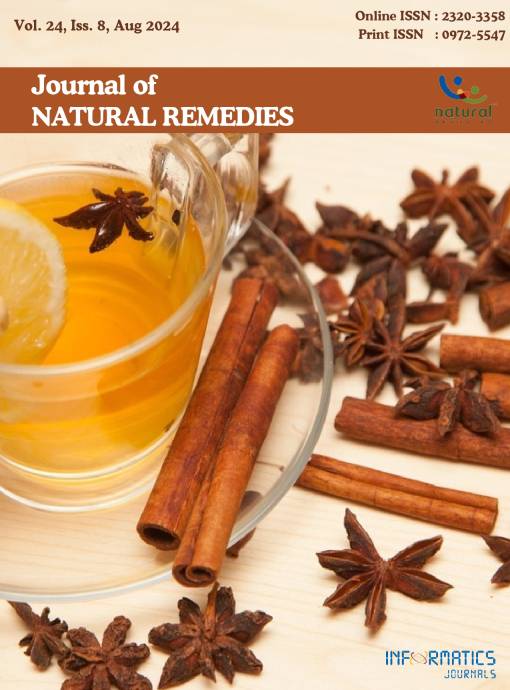Evaluation of Acute and Sub-acute Toxicity Analysis of Root Powder of Pygmaeopremna herbacea (Roxb.) Moldenke
DOI:
https://doi.org/10.18311/jnr/2024/44128Keywords:
Acute Toxicity, Bronchial Asthma, Herbal Medicine, Pygmaeopremna herbacea, Root Powder, Sub-acute ToxicityAbstract
Background: Root powder of Pygmaeopremna herbacea (Roxb.) In traditional medicine, Moldenke, the Verbenaceae family, is widely used for managing respiratory-related disorders like bronchial asthma and pneumonia. Aim: This study aimed to assess the acute and subacute toxicity of the root powder of P. herbacea. The drug powder was prepared according to the standard traditional classical textbook. Methods: Sub-acute and acute toxicity were evaluated using WHO standards in Wistar albino rats and Swiss albino mice, respectively. The animals were administered 2000 mg/kg of the test drug in the acute toxicity trial, and for up to 14 days, any toxic symptoms and death were monitored. The test drug was administered to the animals for up to 28 days at dosages of 200, 100, and 50 mg/kg/BW/p.o./day in a sub-acute toxicity trial, and their morbidity and mortality were evaluated. The study was concluded with the sacrifice of all experimental animals and the completion of the evaluation of all hematological, biochemical, and histopathological assessments. Results: The acute toxicity investigation revealed no potentially dangerous signs of mortality. Animals in the sub-acute toxicity study did not show noteworthy variations in body weight alterations, water and food consumption, or haematological, biochemical, or histopathological features among the experiment and the control groups. Conclusion: According to this study, experimental animals receiving a long-term oral dosage of 200 mg/kg/BW of root powder of P. herbacea did not experience any harmful adverse reactions, stating that the human utilisation of the test drug is safe.
Downloads
Metrics
Published
How to Cite
Issue
Section
Categories
License
Copyright (c) 2024 C. B. S. Bharath Christian, S. Ethel Shiny, J. Jayalakshmi, G. Thirunarayanan, P. Nirmaladevi, S. Harish Titto (Author)

This work is licensed under a Creative Commons Attribution 4.0 International License.
Accepted 2024-07-18
Published 2024-08-31
References
Doeing DC, Solway J. Airway smooth muscle in the pathophysiology and treatment of asthma. J Appl Physiol. 2013; 114(7):834-43. https://doi.org/10.1152/ japplphysiol.00950.2012 PMid:23305987 PMCid: PMC3633438
Global burden of 369 diseases and injuries in 204 countries and territories, 1990-2019: a systematic analysis for the Global Burden of Disease Study 2019. Lancet. 2020; 396(10258):1204-22. https://doi.org/10.1016/S01406736(20)30925-9 PMid:33069326
Williams DM, Rubin BK. Respiratory Care. 2018; 63(6):64154. https://doi.org/10.4187/respcare.06051 PMid:29794201
Ekor M. The growing use of herbal medicines: issues relating to adverse reactions and challenges in monitoring safety. Front Pharmacol. 2014; 4:177. https://doi.org/10.3389/fphar.2013.00177 PMid:24454289 PMCid: PMC3887317
Murugesamuthaliyar KS, Siddha MateriaMedica PartI, Plant divison - II Edition-, Indian Medicine and Homeopathy Department Chennai- 600106. 2018. p. 215-6.
Chauhan A, Semwal DK, Mishra SP, Semwal RB. Ayurvedic research and methodology: Present status and future strategies. Ayu. 2015; 36(4):364-9. https://doi.org/10.4103/09748520.190699 PMid:27833362 PMCid: PMC5041382
Van Norman GA. Limitations of animal studies for predicting toxicity in clinical trials: Is it time to rethink our current approach? JACC Basic Transl Sci. 2019; 4(7):845-54. https://doi.org/10.1016/j.jacbts.2019.10.008 PMid:31998852 PMCid: PMC6978558
Alshammari TM. Drug safety: The concept, inception and its importance in patients’ health. Saudi Pharm J. 2016; 24(4):405-12. https://doi.org/10.1016/j.jsps.2014.04.008 PMid:27330371 PMCid: PMC4908051
Nemes K, Åberg F, Gylling H, Isoniemi H. Cholesterol metabolism in cholestatic liver disease and liver transplantation: From molecular mechanisms to clinical implications. World J Hepatol. 2016; 8(22):924-32. https://doi.org/10.4254/wjh.v8.i22.924 PMid:27574546 PMCid: PMC4976211

 C. B. S. Bharath Christian
C. B. S. Bharath Christian









 0.35
0.35 24
24 0.161
0.161